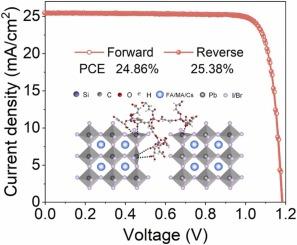高支化聚硅氧烷多齿螯合缺陷钝化制备高效稳定的倒钙钛矿太阳能电池
IF 17.1
1区 材料科学
Q1 CHEMISTRY, PHYSICAL
引用次数: 0
摘要
聚合物添加剂具有多种官能团和优异的稳定性,在钝化钙钛矿缺陷以提高钙钛矿太阳能电池(PSCs)效率方面具有明显的优势。然而,常用的传统线性聚合物表现出有限的钝化能力,这阻碍了器件性能的进一步提高。在此,我们提出了一种多齿螯合缺陷钝化策略,通过将具有马来酸结构的聚硅氧烷(HPSiM)作为块体添加剂引入钙钛矿活性层。HPSiM聚合物具有超支化结构,其中每个支链都含有丰富的电子给体官能团,从而具有更广泛的活性谱和更强的螯合作用,最终促进与Pb2+离子的多齿螯合。HPSiM与钙钛矿晶体的相互作用延缓了钙钛矿晶体的成核和生长,促进了高质量钙钛矿薄膜的形成,同时减少了非辐射复合,最终提高了器件的效率和稳定性。因此,在55°C的最大功率点跟踪下,经过1000小时老化后,hpsim改性的psc效率达到25.38%,保持其初始值的91.6%。我们的研究提出了一个强大的策略,旨在设计具有多齿螯合功能的超支化聚合物,旨在提高psc的性能。本文章由计算机程序翻译,如有差异,请以英文原文为准。

Multidentate chelation defect passivation via hyperbranched polysiloxane for efficient and stable inverted perovskite solar cells
Polymer additives with diverse functional groups and excellent stability offer distinct advantages in passivating perovskite defects to boost the efficiency of perovskite solar cells (PSCs). However, conventional linear polymers commonly used exhibit a restricted capacity for passivation, which hinders further improvement of device performance. Here, we propose a multidentate chelation defect passivation strategy by introducing a polysiloxane with maleic acid structure (HPSiM) into the perovskite active layer as bulk additives. The HPSiM polymer features a hyperbranched architecture where each branch chain is rich in electron-donor functional groups, enabling a broader spectrum of activity and stronger chelation, ultimately facilitating multidentate chelation with Pb2+ ions. The interaction of HPSiM with perovskite crystals delays nucleation and crystal growth, facilitating the creation of high-quality perovskite films while reducing non-radiative recombination, ultimately improving both device efficiency and stability. Consequently, the efficiency of HPSiM-modified PSCs achieves 25.38 %, retaining 91.6 % of its initial value following 1000 hours of aging under maximum power point tracking at 55°C. Our research presents a robust strategy aimed at the design of hyperbranched polymers endowed with multidentate chelating functionality, intending to enhance the performance of PSCs.
求助全文
通过发布文献求助,成功后即可免费获取论文全文。
去求助
来源期刊

Nano Energy
CHEMISTRY, PHYSICAL-NANOSCIENCE & NANOTECHNOLOGY
CiteScore
30.30
自引率
7.40%
发文量
1207
审稿时长
23 days
期刊介绍:
Nano Energy is a multidisciplinary, rapid-publication forum of original peer-reviewed contributions on the science and engineering of nanomaterials and nanodevices used in all forms of energy harvesting, conversion, storage, utilization and policy. Through its mixture of articles, reviews, communications, research news, and information on key developments, Nano Energy provides a comprehensive coverage of this exciting and dynamic field which joins nanoscience and nanotechnology with energy science. The journal is relevant to all those who are interested in nanomaterials solutions to the energy problem.
Nano Energy publishes original experimental and theoretical research on all aspects of energy-related research which utilizes nanomaterials and nanotechnology. Manuscripts of four types are considered: review articles which inform readers of the latest research and advances in energy science; rapid communications which feature exciting research breakthroughs in the field; full-length articles which report comprehensive research developments; and news and opinions which comment on topical issues or express views on the developments in related fields.
 求助内容:
求助内容: 应助结果提醒方式:
应助结果提醒方式:


